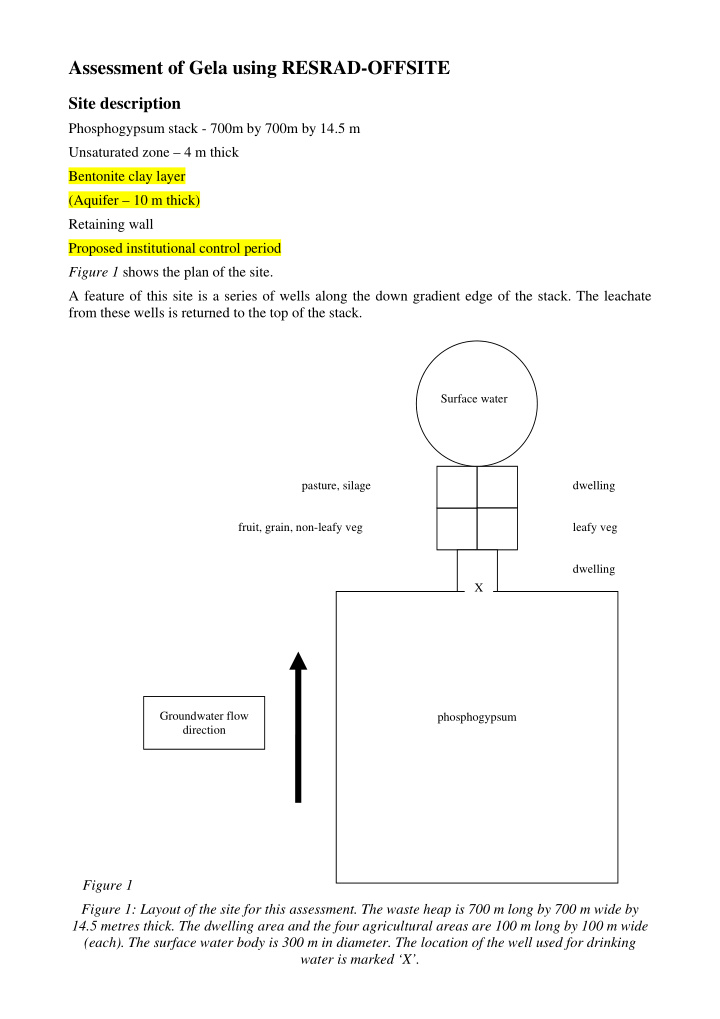



Assessment of Gela using RESRAD-OFFSITE Site description Phosphogypsum stack - 700m by 700m by 14.5 m Unsaturated zone – 4 m thick Bentonite clay layer (Aquifer – 10 m thick) Retaining wall Proposed institutional control period Figure 1 shows the plan of the site. A feature of this site is a series of wells along the down gradient edge of the stack. The leachate from these wells is returned to the top of the stack. Surface water pasture, silage dwelling fruit, grain, non-leafy veg leafy veg dwelling X phosphogypsum Groundwater flow direction Figure 1 Figure 1: Layout of the site for this assessment. The waste heap is 700 m long by 700 m wide by 14.5 metres thick. The dwelling area and the four agricultural areas are 100 m long by 100 m wide (each). The surface water body is 300 m in diameter. The location of the well used for drinking water is marked ‘X’.
Figure 2 shows the vertical profile used for the modelling. At the actual site there is no aquifer, and the phosphogypsum is underlain by a layer of bentonite clay with a much lower hydraulic conductivity than that assumed for the unsaturated layer in the model runs. phosphogypsum 14.5 m 4 m unsaturated zone aquifer 10 m Figure 2: The assumed vertical profile for the modelling Modelling To a first approximation, because of the recirculation of leachate to the top of the stack, the phosphogypsum stack at Gela is a closed system. With this in mind, RESRAD-OFFSITE can be used to perform a simple assessment, by setting the rainfall to a very low value. For this exercise the precipitation rate was set to 0.001 metres per year. In addition, the soil erodibility factor was changed from the default value of 0.4 to a value of 0.1. Pathways: external exposure, inhalation, soil ingestion, radon Source term The waste in this case is phosphogypsum, so the radionuclides of interest are Ra-226 (assumed to be in equilibrium with its decay products) and Ra-228 (assumed to be in equilibrium with its decay products). The Ra-226 concentration (average) is assumed to be 1.249 Bq/g, and the Ra-228 concentration (average) is assumed to be 0.04 Bq/g. Site Parameters Cover= 0 meters Area of contaminated zone: 490000 m 2 Thickness of contaminated zone: 14.5 m Contaminated zone hydraulic conductivity: 158 m/y Unsaturated zone hydraulic conductivity: 0.001 m/y (lower band) Thickness of the unsaturated zone: 4 m (well)
Results The results of the calculations are shown in Figure 3 and Figure 4 . Figure 3: Total doses for the Ra-226 and Ra-228 series Figure 4: Doses for different pathways.
Discussion The long-term environmental impact of the site will clearly depend on the integrity of the retaining wall. Once the site is no longer under any form of regulatory control, and the leachate is no longer being recirculated, the assumption on which this work is based is no longer valid. However, the major radionuclide is Ra-226, with a half-life of 1600 years. Therefore, if the integrity of the retaining wall is maintained beyond one half-life, the flow of leachate under the base of the wall will still be very low, because of the low permeability of the clay layer into which the wall penetrates. This means that it is likely that the results of the calculations carried out here will still be a reasonable approximation well beyond the likely institutional control period. The modelling assumes that there is a 10 m thick aquifer beneath a 4 m thick unsaturated zone. In fact there is no aquifer, and the unsaturated zone consists of a layer of bentonite clay. Any groundwater flow occurs above this layer and is inhibited by the retaining wall. This reinforces the conclusion that the doses are likely to remain very low well beyond the likely institutional control period. The calculations in this work assume a house at the edge of the phosphogypsum stack, and show that the estimated doses would be of concern for at least 1000 years. However, if the land were released for recreational use, the exposure time per year would be at least a factor of five lower than for the case considered here; this is comparable with local variations in the natural background and would probably be acceptable. The phosphogypsum may contain Th-232 and its decay products (probably at or close to background concentrations). The calculations suggest that any Th-232 in the stack will have negligible off-site impact. The modelling shows very clearly that (in general) preventing ingress of rainwater or surface water to the contaminated zone (the phosphogypsum stack) has a significant effect on the transfer of radionuclides to the surrounding environment.
Recommend
More recommend